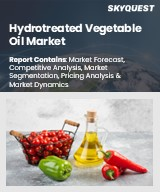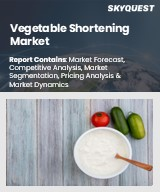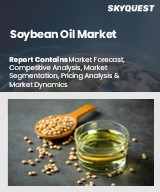
|
시장보고서
상품코드
1661281
대두유 시장 보고서 : 최종 용도별, 지역별(2025-2033년)Soybean Oil Market Report by End-Use (Food, Feed, Industrial), and Region 2025-2033 |
||||||
세계의 대두유 시장 규모는 2024년 6,230만 톤에 달했습니다. IMARC Group은 2025년부터 2033년까지의 시장 성장률(CAGR)은 1.7%로, 2033년에는 7,230만 톤에 달할 것으로 예측했습니다. 개인 차원에서 식용유 수요가 증가하고 있으며, 다양한 산업용도로의 이용이 증가하고 있으며, 세계 대중들 사이에서 건강에 대한 의식과 의식이 높아지고 있는 것이 시장을 추진하고 있는 주요 요인의 일부입니다.
대두유는 글리신 맥스로 알려진 대두 식물의 씨앗에서 얻은 식물성 기름입니다. 온화한 맛과 높은 발연점을 가지며 요리, 튀김, 구이에 자주 사용됩니다. 중립적 인 맛으로 식품의 자연스러운 맛을 손상시키지 않는 비용 효율적인 식용유입니다. 마가린, 마요네즈, 샐러드 드레싱, 소스, 스낵 과자의 제조에 널리 이용되고 있기 때문에 대두유 수요는 세계적으로 증가하고 있습니다.
현재 보다 건강하고 지속 가능한 식품을 선택하고자 하는 개인 수요 증가가 시장 성장을 강화하고 있습니다. 이에 따라 보습성이 우수하기 때문에 화장품 업계에서 대두유의 채용이 증가하고 있는 것도 시장의 성장에 기여하고 있습니다. 이외에도 전 세계 레스토랑, 카페, 호텔 및 기타 패스트 푸드 체인 증가로 대두유 수요가 증가하면 시장에 긍정적인 영향을 미칩니다. 게다가 로션, 크림, 비누 등 보습이나 피부 건강 증진을 목적으로 하는 스킨케어 제품에 대두유의 이용이 증가하고 있는 것도 시장의 성장을 뒷받침하고 있습니다. 또한 세계 온라인 및 오프라인 유통 채널에서 대두유를 광범위하게 이용할 수 있다는 점도 시장 성장을 지원합니다.
대두유 시장 경향/성장 촉진요인
식용유 수요 증가
세계 대중들 사이에서 대두유 등 식용유에 대한 수요가 높아지고 있습니다. 몸에 해를 주지 않고 건강을 유지하는 안전한 식품을 선호하는 사람이 증가하고 있습니다. 또한 세계 대중들 사이에서 다양한 식품에 대한 수요가 높아지고 있기 때문에 식품·식용유의 채용이 증가하고 있습니다. 사람들은 종종 요리와 볶음에 식용유를 사용해야 하는 편리하고 가공된 식품을 선호합니다. 개인의 식생활 패턴의 변화에 따라 식용유의 소비량이 증가하고 있습니다. 또한 세계 각국의 요리와 패스트 푸드 체인의 인기가 높아지고 있는 것도 시장에 긍정적인 영향을 미치고 있습니다.
개인의 건강 의식과 의식 증가
세계 소비자의 건강 의식이 증가함에 따라 대두유 수요가 증가하고 있습니다. 영양가가 높은 식품을 선호하는 경향이 강해지고 시장 전망은 밝습니다. 대두유는 좋은 지방산 조성으로 인해 더 건강한 선택으로 간주됩니다. 대두유에는 다가 불포화 지방, 1가 불포화 지방, 낮은 수준의 포화 지방이 균형있게 포함되어 있습니다. 또한 대두유는 콜레스테롤 수치를 낮추고 염증을 억제하며 심장 건강을 개선하는 효과가 있습니다. 또한 자유 라디칼에 의한 피해로부터 체내의 세포를 보호하는 항산화 물질도 포함되어 있습니다. 결과적으로 소비자는 다른 식용유를 대체하는 건강한 기름으로 대두유를 빠르게 채택하고 있습니다.
산업용도에서의 이용 확대
대두유는 바이오디젤 제조 원료 등 다양한 산업용도로 이용되고 있습니다. 화석연료를 대체하는 바이오디젤 수요가 증가하고 있으며 시장 성장에 기여하고 있습니다. 대두유는 높은 유분 함량과 좋은 특성으로 인해 바이오 디젤의 주요 원료가 되었습니다. 이산화탄소 배출량을 줄이고 지속가능한 환경을 유지하기 위해, 사람들은 점점 신재생에너지원에 주목하고 있습니다. 이 외에도 대두유는 윤활유, 페인트, 잉크, 코팅제 등 다양한 산업 제품의 생산에 널리 사용됩니다. 대두유는 다용도가 높고 입수하기 쉽기 때문에 다양한 산업 분야에 적합한 매력적인 선택입니다.
목차
제1장 서문
제2장 조사 범위와 조사 방법
- 조사의 목적
- 이해관계자
- 데이터 소스
- 1차 정보
- 2차 정보
- 시장 추정
- 상향식 접근
- 하향식 접근
- 조사 방법
제3장 주요 요약
제4장 서론
- 개요
- 주요 업계 동향
제5장 세계의 대두 산업
- 시장 실적
- 수량 동향
- 금액 동향
- 시장 : 최종 용도별
- 시장 : 지역별
- 시장 예측
제6장 세계의 식용유 산업
- 시장 실적
- 시장 : 지역별
- 시장 : 유종별
- 시장 예측
제7장 세계의 대두유 산업
- 시장 개요
- 시장 실적
- COVID-19의 영향
- 가격 분석
- 주요 가격 지표
- 가격구조
- 가격 동향
- 시장 분석 : 지역별
- 시장 내역 : 최종 용도별
- 시장 예측
- SWOT 분석
- 개요
- 강점
- 약점
- 기회
- 위협
- 밸류체인 분석
- 원재료 조달
- 제조
- 마케팅
- 유통
- 수출
- 최종 용도
- Porter's Five Forces 분석
- 개요
- 구매자의 협상력
- 공급기업의 협상력
- 경쟁도
- 신규 참가업체의 위협
- 대체품의 위협
- 시장 성장 촉진요인과 성공 요인
제8장 시장 실적: 최종 용도별
- 식품
- 시장 동향
- 시장 예측
- 사료
- 시장 동향
- 시장 예측
- 산업
- 시장 동향
- 시장 예측
제9장 시장 주요 지역의 실적
- 중국
- 시장 동향
- 시장 예측
- 미국
- 시장 동향
- 시장 예측
- 브라질
- 시장 동향
- 시장 예측
- 유럽
- 시장 동향
- 시장 예측
- 아르헨티나
- 시장 동향
- 시장 예측
- 인도
- 시장 동향
- 시장 예측
- 기타
- 시장 동향
- 시장 예측
제10장 경쟁 구도
- 시장 구조
- 주요 기업
제11장 대두유 가공
- 제품 개요
- 세부 공정 흐름
- 다양한 유형의 단위 작업
- 질량 균형과 원재료 요구 사항
제12장 프로젝트의 세부 정보, 요구 사항 및 관련 비용
- 토지 요구 사항과 비용
- 건설 요구 사항과 비용
- 공장 레이아웃
- 플랜트 기계
- 기계 사진
- 원재료 요구 사항과 지출
- 원재료와 최종제품의 사진
- 포장 요구 사항과 지출
- 운송 요구 사항과 지출
- 유틸리티 요구 사항과 지출
- 인력 요구 사항과 지출
- 기타 설비투자
제13장 대출과 자금 지원
제14장 프로젝트의 경제성
- 프로젝트의 자본 비용
- 기술 경제적 파라미터
- 공급 체인의 각 단계에서의 제품 가격과 마진
- 과세 및 감가상각
- 수입 예측
- 지출 예측
- 재무 분석
- 이익 분석
제15장 주요 기업 프로파일
- Archer Daniels Midland Company
- Bunge Limited
- Cargill, Incorporated
- Louis Dreyfus Company BV
- Wilmar International Limited
The global soybean oil market size reached 62.3 Million Tons in 2024. Looking forward, IMARC Group expects the market to reach 72.3 Million Tons by 2033, exhibiting a growth rate (CAGR) of 1.7% during 2025-2033. The growing demand for edible oils among individuals, rising utilization in various industrial applications, and increasing health consciousness and awareness among the masses across the globe are some of the major factors propelling the market.
Soybean oil is a vegetable oil that is derived from the seeds of the soybean plant known as Glycine max. It has a mild flavor and high smoke point and is commonly used for cooking, frying, and baking. It is a cost-effective cooking oil that provides a neutral taste and does not overpower the natural flavors of the food. As it is widely utilized in the production of margarine, mayonnaise, salad dressings, sauces, and snack foods, the demand for soybean oil is increasing across the globe.
At present, the rising demand for healthier and more sustainable food choices among individuals is strengthening the growth of the market. In line with this, the increasing adoption of soybean oil in the cosmetic industry due to its moisturizing properties is contributing to the growth of the market. Apart from this, the growing demand for soybean oil on account of the increasing number of restaurants, cafes, hotels, and other fast-food chains around the world is positively influencing the market. In addition, the rising utilization of soybean oil in several skincare products, such as lotions, creams, and soaps, for providing hydration and promoting skin health is bolstering the growth of the market. Furthermore, the wide availability of soybean oil through online and offline distribution channels across the globe is supporting the growth of the market.
Soybean Oil Market Trends/Drivers:
Rising demand for edible oils
There is a rise in the demand for edible oils, such as soybean oil, among the masses across the globe. People are increasingly preferring safe food products that do not harm the body and maintain good health. In addition, the rising adoption of food and cooking oils due to the increasing demand for a variety of food products among the masses around the world. People are preferring convenient and processed food products that often require the use of edible oils for cooking and frying. There is a rise in the consumption of edible oils on account of the changing dietary patterns of individuals. Moreover, the growing popularity of international cuisines and fast-food chains is positively influencing the market.
Increasing health consciousness and awareness among individuals
There is a rise in the demand for soybean oil due to the increasing health consciousness among consumers across the globe. People are increasingly preferring nutrient-rich food products, which is offering a positive market outlook. Soybean oil is considered a healthier choice due to its favorable fatty acid composition. It contains a balanced ratio of polyunsaturated fats, monounsaturated fats, and low levels of saturated fats. In addition, soybean oil may benefit in reducing cholesterol levels, lowering inflammation, and improving heart health. It also has antioxidants that help to protect the cells of the body from damage caused by free radicals. As a result, consumers are rapidly adopting soybean oil as a healthier alternative to other cooking oils.
Growing utilization in industrial applications
Soybean oil has diverse industrial applications, such as a feedstock for biodiesel production. There is a rise in the demand for biodiesel as an alternative to fossil fuels, which is contributing to the growth of the market. Soybean oil serves as a key feedstock for biodiesel due to its high oil content and favorable properties. People are increasingly focusing on renewable energy sources to reduce carbon emissions and maintain a sustainable environment. Apart from this, soybean oil is widely employed in the production of various industrial products, such as lubricants, paints, inks, and coatings. The versatility and availability of soybean oil make it an attractive and suitable choice for different industrial sectors.
Soybean Oil Industry Segmentation:
Breakup by End-Use:
- Food
- Feed
- Industrial
Food represents the largest market segment
The food industry is one of the largest consumers of soybean oil as it is widely used for various culinary purposes, such as cooking, frying, baking, and as an ingredient in processed foods. In line with this, the rising adoption of ready-to-eat (RTE) food products among the masses is contributing to the growth of the market.
In the feed industry, it is used as a component in animal feed formulations. It is included in livestock and poultry feed to provide a source of energy and essential fatty acids. In addition, it assists in improving the palatability and nutritional value of animal feed and enhances the growth and development of livestock.
Soybean oil finds applications in various industrial sectors, as it is used as a feedstock for biodiesel production. In addition, it offers environmental friendliness and is a suitable alternative to conventional diesel fuel.
Breakup by Region:
- China
- United States
- Brazil
- Europe
- Argentina
- India
- Others
China exhibits a clear dominance, accounting for the largest soybean oil market share
The report has also provided a comprehensive analysis of all the major regional markets, which include China, United States, Brazil, Europe, Argentina, India, and others. According to the report, China accounted for the largest market share.
China held the biggest market share as it is the major producer of soybeans. Apart from this, the rising demand for soybean oil on account of the thriving food service industry is contributing to the growth of the market in the country. In line with this, the increasing consumption of processed and convenience food products is propelling the growth of the market in China. Furthermore, the rising adoption of soybean oil due to changing consumer eating habits is bolstering the growth of the market in the country.
India is estimated to expand further in this domain during the forecast period owing to the favorable government initiatives for soybean agriculture. In addition, the rising utilization of soybean oil in households for cooking, frying, and baking purposes is supporting the growth of the market in the country. Besides this, the increasing adoption of soybean oil in the production of snacks is strengthening the growth of the market.
Competitive Landscape:
Key players in the industry are investing in research and development (R&D) activities to improve production processes, develop new product formulations, and enhance the quality and functionality of soybean oil. They are also exploring new extraction techniques, optimizing refining processes, and developing specialty variants of soybean oil to cater to specific customer needs. In line with this, major manufacturers are offering organic or non- genetically modified organism (GMO) variants of soybean oil, introducing specialty blends, and diversifying into value-added products, such as flavored or infused soybean oils. Apart from this, companies are opening soybean oil production facilities across the globe, which is positively influencing the market.
The report has provided a comprehensive analysis of the competitive landscape in the market. Detailed profiles of all major companies have also been provided. Some of the key players in the market include:
- Archer Daniels Midland Company
- Bunge Limited
- Cargill, Incorporated
- Louis Dreyfus Company B.V.
- Wilmar International Limited
Key Questions Answered in This Report
- 1.What was the size of the global soybean oil market in 2024?
- 2.What is the expected growth rate of the global soybean oil market during 2025-2033?
- 3.What are the key factors driving the global soybean oil market?
- 4.What has been the impact of COVID-19 on the global soybean oil market?
- 5.What is the breakup of the global soybean oil market based on the end-use?
- 6.What are the key regions in the global soybean oil market?
- 7.Who are the key companies/players in the global soybean oil market?
Table of Contents
1 Preface
2 Scope and Methodology
- 2.1 Objectives of the Study
- 2.2 Stakeholders
- 2.3 Data Sources
- 2.3.1 Primary Sources
- 2.3.2 Secondary Sources
- 2.4 Market Estimation
- 2.4.1 Bottom-Up Approach
- 2.4.2 Top-Down Approach
- 2.5 Forecasting Methodology
3 Executive Summary
4 Introduction
- 4.1 Overview
- 4.2 Key Industry Trends
5 Global Soybean Industry
- 5.1 Market Performance
- 5.1.1 Volume Trends
- 5.1.2 Value Trends
- 5.2 Market by End-Use
- 5.3 Market by Region
- 5.4 Market Forecast
6 Global Edible Oil Industry
- 6.1 Market Performance
- 6.2 Market by Region
- 6.3 Market by Oil Type
- 6.4 Market Forecast
7 Global Soybean Oil Industry
- 7.1 Market Overview
- 7.2 Market Performance
- 7.3 Impact of COVID-19
- 7.4 Price Analysis
- 7.4.1 Key Price Indicators
- 7.4.2 Price Structure
- 7.4.3 Price Trends
- 7.5 Market Breakup by Region
- 7.6 Market Breakup by End-Use
- 7.7 Market Forecast
- 7.8 SWOT Analysis
- 7.8.1 Overview
- 7.8.2 Strengths
- 7.8.3 Weaknesses
- 7.8.4 Opportunities
- 7.8.5 Threats
- 7.9 Value Chain Analysis
- 7.9.1 Raw Material Procurement
- 7.9.2 Manufacturing
- 7.9.3 Marketing
- 7.9.4 Distribution
- 7.9.5 Exports
- 7.9.6 End-Use
- 7.10 Porter's Five Forces Analysis
- 7.10.1 Overview
- 7.10.2 Bargaining Power of Buyers
- 7.10.3 Bargaining Power of Suppliers
- 7.10.4 Degree of Competition
- 7.10.5 Threat of New Entrants
- 7.10.6 Threat of Substitutes
- 7.11 Key Market Drivers and Success Factors
8 Market Performance by End-Use
- 8.1 Food
- 8.1.1 Market Trends
- 8.1.2 Market Forecast
- 8.2 Feed
- 8.2.1 Market Trends
- 8.2.2 Market Forecast
- 8.3 Industrial
- 8.3.1 Market Trends
- 8.3.2 Market Forecast
9 Market Performance of Key Regions
- 9.1 China
- 9.1.1 Market Trends
- 9.1.2 Market Forecast
- 9.2 United States
- 9.2.1 Market Trends
- 9.2.2 Market Forecast
- 9.3 Brazil
- 9.3.1 Market Trends
- 9.3.2 Market Forecast
- 9.4 Europe
- 9.4.1 Market Trends
- 9.4.2 Market Forecast
- 9.5 Argentina
- 9.5.1 Market Trends
- 9.5.2 Market Forecast
- 9.6 India
- 9.6.1 Market Trends
- 9.6.2 Market Forecast
- 9.7 Others
- 9.7.1 Market Trends
- 9.7.2 Market Forecast
10 Competitive Landscape
- 10.1 Market Structure
- 10.2 Key Players
11 Soybean Oil Processing
- 11.1 Product Overview
- 11.2 Detailed Process Flow
- 11.3 Various Types of Unit Operations Involved
- 11.4 Mass Balance and Raw Material Requirements
12 Project Details, Requirements and Costs Involved
- 12.1 Land Requirements and Expenditures
- 12.2 Construction Requirements and Expenditures
- 12.3 Plant Layout
- 12.4 Plant Machinery
- 12.5 Machinery Pictures
- 12.6 Raw Material Requirements and Expenditures
- 12.7 Raw Material and Final Product Pictures
- 12.8 Packaging Requirements and Expenditures
- 12.9 Transportation Requirements and Expenditures
- 12.10 Utility Requirements and Expenditures
- 12.11 Manpower Requirements and Expenditures
- 12.12 Other Capital Investments
13 Loans and Financial Assistance
14 Project Economics
- 14.1 Capital Cost of the Project
- 14.2 Techno-Economic Parameters
- 14.3 Product Pricing and Margins Across Various Levels of the Supply Chain
- 14.4 Taxation and Depreciation
- 14.5 Income Projections
- 14.6 Expenditure Projections
- 14.7 Financial Analysis
- 14.8 Profit Analysis
15 Key Player Profiles
- 15.1 Archer Daniels Midland Company
- 15.2 Bunge Limited
- 15.3 Cargill, Incorporated
- 15.4 Louis Dreyfus Company B.V.
- 15.5 Wilmar International Limited

















